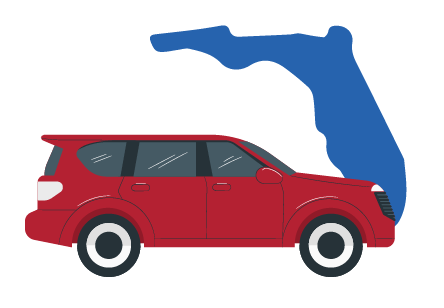Florida is one of the twelve states that use a no-fault auto insurance system. Established in 1972, this framework means your insurer pays your medical bills after an accident, regardless of who was at fault. Drivers in Florida are required to carry at least $10,000 in personal injury protection (PIP), which covers:
- 80% of medical costs, including emergency care, surgeries, etc
- 60% of your lost income if your injury prevents you from working
- 100% for all necessary services like household help or childcare if you’re unable to manage these tasks because of your injury
This system makes the claim process fairly quicker and gets you the medical care right away, no questions asked. This means you get the medical treatment and start coverage while the investigation is still going on.
Legal Thresholds for Injury Claims in Florida
As discussed above, through Florida auto insurance laws, you can file your PIP claim with ease and start getting medical treatment right away. Considering the accident might have involved some serious bodily injuries, getting the treatment, therapy, and wage support before anything else is more than necessary.
Below is a breakdown of how Florida’s legal system works and what qualifies as a serious injury.
Limits on Legal Scale
Under Florida’s PIP rule, you would only have 14 days after the incident to qualify for full PIP benefits, meaning that you would need to begin your medical care as soon as possible.
Note: According to Florida’s legal definition, if your injuries don’t qualify as “serious” or “life-threatening,” you would not be able to sue the other party for the pain, suffering, or other non-economic losses.
Here’s what does count as “serious” under Florida Statute 627.737(2)
Extraordinary injuries proven with strong medical documents, radiology reports, and testimony:
- Loss of sight, limbs, any important body part, or organ
- Loss of bodily function, disfigurement, or permanent paralysis
- Brain injuries
- Severe burns, permanent scarring
- Death
Minor injuries = no lawsuit.
A broken bone or slight scratch can only leave you with $10,000 PIP coverage, no claim for pain or emotional trauma. It may be too early to judge a condition and the coverage you can get unless your disease fits into a serious-injury bar. If you do, you would need to pursue a lawsuit to let the judge and jury decide.
In cases where injuries meet the threshold, and only then, you would need to file a personal injury lawsuit. Getting compensated means you qualify for expenses beyond PIP, such as
- Medical and rehabilitation expenses
- Lost wages
- Pain, suffering, and emotional anxiety
- In some cases, loss of companionship and other damages
Unless your proof clearly explains your serious medical condition, the defense can contest your claim, which can lead the judge to dismiss your case before it reaches the jury.
Florida Car Insurance Requirements and Why Drivers Pay More
Keeping aside the beautiful coastlines and other perks, Florida consistently ranks among the most expensive states for auto insurance. But why do drivers here pay so much more?
MoneyGeek.com’s recent article on 2025 stats explains:
- In Florida, comprehensive and collision coverage with a deductible of $1,000 costs an average of $2,912 per year.
- In Florida, full coverage car insurance costs an average of $243 per month, and for minimum coverage, it sits around $101 monthly.
Florida Car Insurance Laws Mean Higher Rates
That has to do with three major things. According to the Insurance Information Institute, almost 1 in 5 drivers in Florida (about 20%) are uninsured, well above the national average of 12.6%, so insured drivers often end up bearing additional costs to offset risk. The result? Responsible drivers end up paying higher premiums to protect themselves against those without proper insurance.
Secondly, increased weather and natural disaster exposures like hurricanes, tropical storms, and flooding lead to increased claims across the state.
Lastly, Florida is home to some of the highest populous areas, such as Miami, Orlando, and Tampa, with high rates of traffic congestion and accidents, increasing the likelihood of accidents during rush hours.
Florida’s Legal Minimum Coverage Requirements
To legally drive in Florida, you must have two types of auto insurance.
- Personal Injury Protection (PIP) - $10,000
- Property Damage Liability (PDL) - $10,000
PIP covers your own medical expenses after your accident, while PDL pays for damages caused to another person’s vehicle.
PDL specifically covers areas where you are at fault, for example:
- Repairing or replacing another driver’s vehicle
- Property repairs such as a damaged fence, mailbox, or building
- Other personal property damage, such as hitting a motorcycle or landscaping
Why is (BIL) Bodily Injury Liability Highly Recommended?
Florida does not require drivers to carry (BIL) Bodily Injury Liability coverage. This coverage pays for injuries you cause to others in an accident, including medical expenses, lost wages, and legal fees if you’re sued.
In other words, it’s like PDL and BIL are just PIP but for the insurance of the other party, so you are not liable to pay much out of your pocket in case of any accident.
Below is a quick example that shows how these coverages actually apply.
Example: Accident with Both PIP and PDL Coverage Looks Like
Scenario: Imagine you’re driving home and rear-end another vehicle near a beach stop in Miami.
PIP Coverage: you suffer minor fractures and visit the ER, and begin medical treatment within 14 days of the crash. Since it’s not a serious injury, you’re covered up to $10,000 under the PIP limit.
PDL Coverage: You also hit the motor vehicle in the front, causing permanent damage to the bumper and the trunk. The damage totals $6,800. Since you’re well within your $10,000 PDL limit, the coverage will cover the other driver’s repair costs.
In any case, if the bill piles up from both sides, you could be personally responsible for covering the difference in case the $10,000 cap is reached.
When BIL Becomes Mandatory: DUI and Other Offenses
Drivers convicted of serious offenses like Driving Under the Influence (DUI) and obligated by law to carry Bodily Injury Liability (BIL) coverage with minimum limits of $10,000 per person and $20,000 per accident.
That’s because a DUI conviction is a high risk to both the state and the insurance companies.
How Long Must You Maintain This Coverage?
However, this is not a lifelong coverage. Individuals carrying a DUI need to maintain BIL coverage limits for a minimum of three years after license reinstatement.
FR‑44 Certificate: Florida’s Strict Proof of Financial Responsibility
If you are convicted of driving under the influence, expect some challenges. First, the state might require you to maintain a higher insurance limit, which also mandates that your insurance company files Florida FR‑44 or SR-22 certificates of financial responsibility with DMV. You have to carry this document/certificate all the time while driving, which explains you’re legally able to drive as you carry the elevated coverage. Below, we will talk about the key difference between FR-44 and SR-22.
Difference Between FR‑44 Different From SR‑22
Neither FR-44 nor SR-22 is an insurance policy. Instead, they prove that your insurer carries required coverage.
SR‑22: Used for non-DUI violations, less severe driving offenses, such as driving uninsured, multiple minor violations, or driving with a suspended license. Individuals with these violations often need an SR‑22 to reinstate or maintain driving privileges. The minimum liability thresholds are
- $10,000 per person
- $20,000 per accident (BIL)
- $10,000 for property damage (PDL)
FR‑44: Used for DUI convictions in Florida and Virginia. As explained, it requires a bit higher liability coverage. It is also known as 100/300/50 liability limits for DUI.
- $100,000 bodily injury per person
- $300,000 bodily injury per accident
- $50,000 property damage per accident
You must check with your insurer to ensure which certificate you are required.
Duration & Continuous Compliance
After you commit an offense, your license is reinstated immediately. Florida requires that both SR‑22 and FR‑44 (depending on your situation and offense) must be filed immediately and must be maintained continuously for three years. The end of the three-year period usually ends at the incident date being completed.
If for any reason your coverage cancels during this period, your insurer must notify the DMV, which may lead to license suspension or starting the 3 years all over again.
You are allowed to change insurers or move, but coverage must never lapse, and the new coverage provider must file the certificate with the Florida Department of Highway Safety and Motor Vehicles (FLHSMV) before your old policy expires.
Why the Higher Coverage, Liability Insurance & Stricter Filing?
Government and insurance companies see DUI as a threat and risk of causing serious injury and damage. The FR‑44 ensures you have greater financial protection and a formal record of your coverage.
How This Insurance Works
According to the Florida car insurance requirements, if your license gets reinstated because of a DUI, you need to immediately call your insurer and request to file a FR‑44 filing. Remember that you don’t need to file it yourself; the insurer will do it for you. The insurer will attach it to your existing policy and send it electronically to the Florida DMV.
Consequences of Non‑Compliance
If caught, driving without a valid FR‑44 can cause an immediate license suspension that won’t allow you to drive legally, even after DUI reinstatement fees.
Do You Need Both SR‑22 and FR‑44?
Do You Need Both SR‑22 and FR‑44? No, only one is needed. In Florida, if you’re facing DUI-related violations, you would need to file DR-44, which already covers all SR‑22 requirements.
Why FR‑44 Overrides SR‑22
FR‑44 has higher coverage levels, also known as the 100/300/50 liability limits, which exceed SR‑22’s 10/20/10 minimum. Also, Florida’s Department of Motor Vehicles (DMV) sees FR-44 as enough for high-risk requirements, which satisfy and fulfill all the filing requirements.
What Is UM/UIM Coverage?
Uninsured Motorist (UM) and Underinsured Motorist (UIM) coverage are add-ons to your insurance policy to protect you from drivers who have no liability insurance or not enough insurance to cover the damages. Hit-and-run scenarios could leave you to pay out of your pocket unless you carry UM/UIM coverage. Both incidents are pretty common and might leave you to deal with your own expenses and bills if an unfortunate situation happens. Listed below are the details on how UM/UIM coverage actually works in Florida.
Auto Insurance Requirements in Florida and How UM/UIM Works
Uninsured Motorist (UM) kicks in when the at-fault driver doesn’t have insurance to cover bills, medical expenses, and even property damage. In any instance that your at-fault driver doesn’t have enough liability limits to support your expenses, your UIM can make up the difference, up to your policy limits.
Who and What It Covers
The good thing about UM/UIM coverage is that it is intended for you and your passengers, family members in your vehicle, or permitted drivers using your car.
Florida does not require UM/UIM coverage to legally drive your vehicle. Most insurers still offer it, and if you decline, you must opt out in writing.
Risks of Under-Insuring
Listed below are the major financial and legal risks of under-insuring in Florida.
Financial Risk from Uninsured Drivers with Minimum Insurance
As mentioned above, Florida ranks amongst the highest in the nation for unserviced or underinsured drivers, about 20% (7th) uninsured and nearly 38% underinsured (2nd) in 2025, both of which are really harmful for you. If an underinsured driver hits you and you lack Uninsured/Underinsured Motorist (UM/UIM) coverage, you might be responsible for your own bills and expenses beyond your $10,000 PIP insurance limit.
Florida Minimum Might Not be Enough
Even though Florida’s legal minimum requirements ($10,000 PIP & $10,000 PDL) may sound sufficient but it gets used up quickly, especially in serious accidents. Modern medical care, hospital visits, emergency services, repair costs, and legal bills can exceed the limits in a single visit, leaving you to cover all the costs out of your pocket.
PIP insurance is like no-fault insurance that covers expenses until it reaches its limit, and after that, an individual is personally responsible for the remaining bills.
The Risk of Injury Liability
Without proper Property Damage Liability (PDL) or Bodily Injury Liability (BIL), you could be personally responsible for covering the costs involved in fault incidents. These might exceed your policy limits. In fact, according to a recent article published by Steinger, Greene & Feiner, it’s no secret that in Florida, damages often blow past insurance limits, especially when the injuries are catastrophic.
Hit-and-Run Risks
Florida reports over 97,000 Hit-and-Run crashes in 2024. Hit-and-run crashes have surged across Florida, with a 40% increase over the past decade, according to the Florida Department of Highway Safety and Motor Vehicles (FLHSMV). If the at-fault driver flees the scene, getting compensated gets even more difficult. Hence, you’re left with no options.
Many experts recommend at least 100/300/100 liability limits, with an optional umbrella policy for added security, especially in high-risk states like Florida.
Why Minimum Is Not Enough
Sure, the minimum auto insurance requirement of (PIP $10K and PDL $10K) can legally keep you safe, but this baseline protection is not enough. Living in a state like Florida, where car insurance prices and medical expenses continue to rise, relying just on your minimum coverage in hopes of it covering everything is not enough. To protect yourself from a big financial crunch, it’s important to upgrade your liability to at least 100/300/100. The UI/UIM coverage can shield you from uninsured or underinsured drivers.
Recommendations for Adequate Coverage
Start with boosting your liability limits. Florida doesn’t require Bodily Injury Liability (BIL), but it’s strongly recommended for those who drive frequently. You can also extend PIP up to $50,000 or $100,000, or add $5,000 in your additional medical coverage (also known as MedPay. Listed below are key features, coverage amounts, and eligibility details you should know.
Consider an Umbrella Policy
Umbrella policy is not limited to Florida; it’s equally common in most states. Just like its name, it offers an extra layer of coverage and protection beyond the limits for auto, homeowners, or other insurance coverage.
Insurance Limits + What Do You Get?
- The umbrella policy kicks in when your auto or home policies have reached their limit. This policy starts at $1 million and goes up to 5 million or more.
- It offers broader protection, unlike standard liabilities and covers incidents like slander, false arrest, injuries from pets, etc, even some not included in your standard policy.
In order to become eligible for this policy, you would need high limits on primary policies. In general, you would need at least $250K-$300K for auto and $300K for home before insurers can add an umbrella policy on top of your other coverages.
Quick take: A Broader coverage scope is beneficial if you have sufficient assets. This insurance helps you in case of any major claim that could put your home, savings, and earnings at risk.
How to Secure Strong Auto & Home Coverage (Including Umbrella Coverage)
The proven ways to boost your coverage and reduce financial strain are listed below.
Start with an Insurance Coverage Assessment
Take a look at your total assets, including savings, investments, home equity, and income. Consider your liabilities and how frequently you travel. An article published on the Horton Group in 2022 clearly mentions that if you’re trying to secure an umbrella coverage, it should be at least equal to your net worth.
Increase Liability Coverage
Choose higher primary limits rather than the minimum required by Florida, which can protect you against lawsuits and major incidents.
Add Uninsured / Underinsured Coverage (UM/UIM)
Add this coverage to your policy to ensure you’re protected against underinsured and uninsured drivers if any unforeseen circumstance happens.
Include Medical Payments or Extended PIP
Modern medical costs exceed $10,000 in value and are not enough in case an accident occurs. Adding MedPay or upping your PIP to $25K-$50K can help you cover out-of-pocket expenses.
How to Shop Wisely & Save Money
Listed below are practical steps to shop with confidence and lower your insurance costs.
Shop Smart & Bundle Policies
Bundling up offers from the same insurer can get you discounts. Try getting home and auto policies under one company and have a preferred agent. This offers convenience and has a single point of contact for claims.
When Bundling Might Not Be Best
Indeed, bundling isn’t always the cheapest option. Sometimes, different providers offer better policies if you are a new customer, which raises the cost over time. It’s important to cover bundled quotes with separate policies to see which one fits your situation and saves you money.
Conduct Annual Coverage Reviews
Take a time out every year, possibly during January, and review your policies, renewal time. If you recently had a baby or a major life change, it’s important to see if you want extended coverage. Reviewing annually ensures you’re covered based on the current risk levels.
What to Check During Reviews
Below are key areas to focus on when reviewing your insurance.
Policy Documents & Expiration Dates
Check for policy documents, renewal notices, and expiration dates. Set a reminder at least 30 days before renewal so you have enough time to compare options.
Coverage Levels & Deductibles
Take a check of your finances. Ensure that your liability aligns with your net worth. Consider adding or subtracting deductibles. If you’re opting for lower premiums, you may be responsible for a higher deductible.
New Risks & Coverage Gaps
Confirm whether your policy still covers everything that is high value, including specialty vehicles. If risks have increased, consider liability exposures and upgrading your policy premium.
Discounts & Savings
Insurers offer a lot of discounts, and you might be eligible for some multi-policy, safety, good driver, senior, loyalty, or pay-in-full discounts. However, the insurers may limit you to selecting only one of the discounts. This can make sure you’re getting the best available rates as a driver.
Car Insurance Requirements in Florida. Have They Changed?
Regional or state changes can cause an increase in inflation and added cost. It’s best to compare Florida auto insurance quotes from at least three insurers to check if your current company is still offering you the best value.
If you feel you have questions, get an independent agent who can help you cover gaps, overlaps, and saving opportunities. They’re valuable, especially during renewal stages.
Speak with an Insurance Navy agent today to explore affordable, personalized car insurance options. They’ll shop multiple carriers to help you find the best coverage at the lowest rate, even if you’ve had past issues with credit or tickets.
Flexible payment plans and convenient policy management options are available. Buy today, drive insured tomorrow.
Request your free quote now, online or by phone, and let the Insurance Navy guide you to smarter, stronger coverage.





